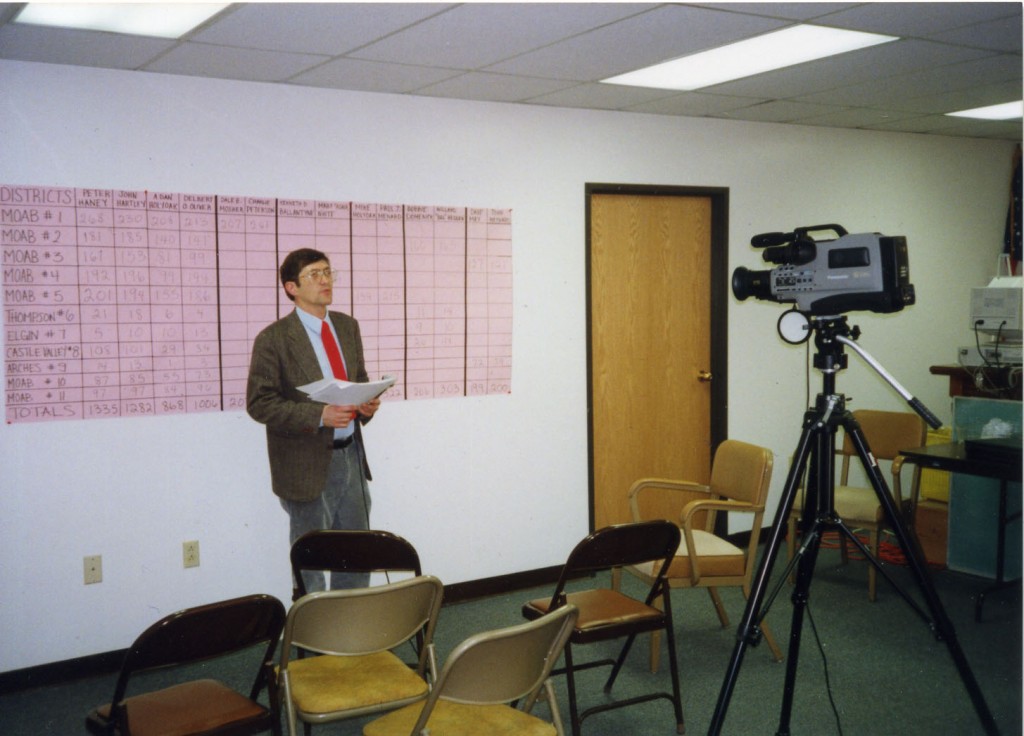
Fact:
“We need to get control, because right now, it’s out of control.”
“Where are the guidelines?”
“We need direction.”
All the above are quotes from Moab City Council members during a May 5 discussion of the impacts of bed and breakfasts, overnight accommodations, and the influx of visitors to Moab during the spring of 1992.
Opinion:
The council is right that certain aspects of tourism are out of control. But they fail to acknowledge their own role in that development.
More people are pouring into town than ever before. The record-breaking visitation numbers at Arches National Park in 1991 now look puny compared to this spring so far. In addition, the number of people coming who never go near the park, but spend their time on BLM land. There were groups camping in parking lots, lining up at City Market, pitching their tents in back and front yards, occasionally without the permission of the homeowners.
Understandably, the council does not want to shut down the flow of visitors; too many local residents make their living from out of town guests, in the restaurants, gift shops, and tour businesses. But at the same time, council members want to be in a position where they can direct some of the changes that, right now, are taking place with no planning at all.
But council members have had opportunities to make statements, in words and in action, that they truly want to gain that control. And in almost every case, they have pulled back, because they didn’t want to appear to stand in the way of development plans.
CASE HISTORY #1—At the north end of the valley, an RV park has been built right along the highway and just south of the river bridge, outside the city limits. As always, zoning for the area was changed by the county commission because as a group they don’t believe in zoning and, without any deliberation whatsoever, they turned the grazing area into a commercial zone.
That area is not part of the sewer system, and the county gave permission for a septic system to serve the campers and trailers. But for water, the developers had to come to the city and request a hookup.
Council members could have asked how the development would affect the groundwater, or how it would affect the future visual quality of the north end of the valley, or the impact on the wetlands preserve, or the effect on any other services needed by a couple of hundred campers on the rim of the city. But, rather than seem anti-development, they held their collective tongue. In fact, they even told the developers that if the city ever annexed the area, they would not be bound by the rules and regulations regarding curbs and gutters that the rest of the city must follow.
CASE HISTORY #2—The Canyonlands Motel construction project at Center and Main streets wanted to tear out the mid-sized trees fronting Main Street as part of their building effort. The city’s Shade Tree Commission said, well, if you tear out the trees spread about 40 feet apart, you should plant new ones 20 feet apart. The trade, from the Shade Tree Commission’s point of view, was more trees in exchange for shorter trees over the next decade or so.
The developers didn’t like that idea, but went along with it. But not before they complained to the council that it cost them, out of a total budget of probably at least $2.5 million, as much as $200 more than they wanted to spend.
Council members did not ask why the developers had to tear out the original trees, and did not talk about the need to keep shade in the most central area of the city. Instead, in the main, they went out of their way to explain to the motel’s general manager that the Shade Tree Commission would not get out of line again.
CASE HISTORY #3—The State of Utah has, as part of its Unified Building Code, a provision that excavation work on large amounts of dirt should require certain pre-construction licensing and engineering requirements. In the past, Moab neighborhoods have been damaged by inadequate planning for drainage and runoff, and residents along Hillside, for example, have been paying for those inadequacies after every major storm, with cleanup bills and damage to their properties.
The city building inspector and the city’s planning department were both in favor of adopting the new code. But at the public hearing on the ordinance, one local contractor said, in essence, we don’t need any more regulations.
And the council members in their majority agreed. By golly, you can’t actually make people do engineering before they change the drainage for vast areas of the city, that’s just more than we can stand.
Those are just three examples from the last couple of months when the council had golden opportunities to “take control,” to set “guidelines,” to determine “direction.” And in each case the council decided to pull back from taking a hard position.
In truth, the council doesn’t need “control.” It already has it, if it chooses to exercise it. The council doesn’t need “direction.” It needs political will.
And anti-development view is not what is required, nor is it likely. But if elected officials defer and demur from taking action every time a developer or contractor complains, they are letting down the other 99 percent of the city’s residents, who want to feel that city leaders are taking their concerns into account.



















One Response
Stay in touch with the conversation, subscribe to the RSS feed for comments on this post.
Continuing the Discussion